tire size MERCEDES-BENZ METRIS 2021 MY21 Operator's Manual
[x] Cancel search | Manufacturer: MERCEDES-BENZ, Model Year: 2021, Model line: METRIS, Model: MERCEDES-BENZ METRIS 2021Pages: 290, PDF Size: 4.68 MB
Page 101 of 290
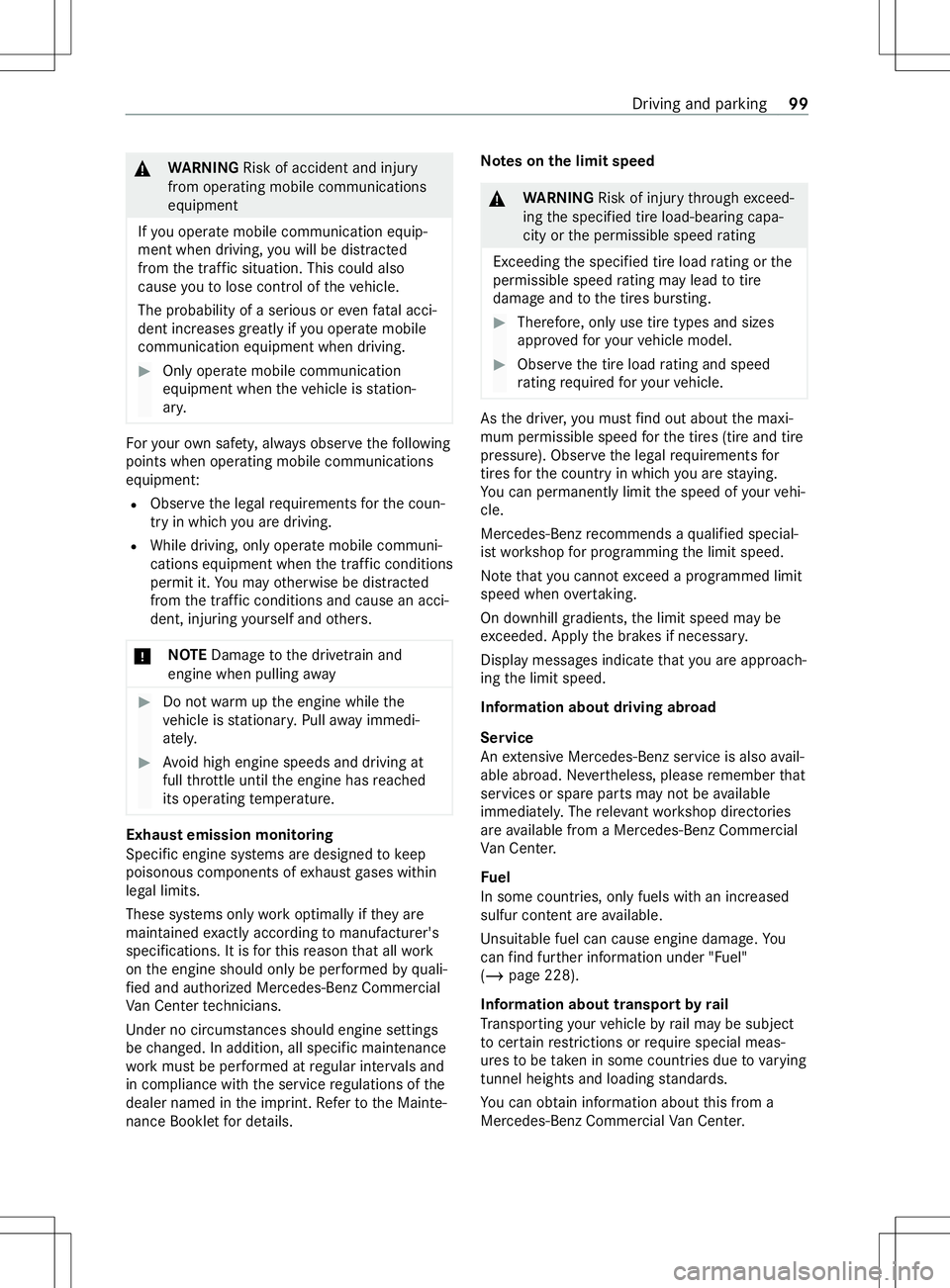
&
WARNING Risk of accident and inju ry
from operating mobil ecommunications
equipment
If yo uo perat emobile communication equip‐
men twhen driving, youw ill be distracted
from thet raffic situation .Thisc ould also
cause youtol ose control of thev ehicle.
The probability of aserious or evenfatal acci‐
dent inc reases greatl yifyou operat emobile
communication equipment when driving. #
Only operat emobile communication
equipment when thev ehicle is station‐
ar y. Fo
ry our owns afet y, alwa ys obser vethef ollowing
points when operating mobile communications
equipment:
R Obser vethel egal requ irements fort he coun‐
tr yinw hichyou ar edriving.
R While driving, on lyoperat emobile communi‐
cations equipment when thet raffic conditions
permit it. Youm ayotherwise be distracted
from thet raffic condition sand cause an acci‐
dent, inju ring yourself and others.
* NO
TEDama getothed rive trai nand
engin ewhen pulling away #
Do no twarmupt he engine while the
ve hicle is stationar y.Pull away immedi‐
atel y. #
Avoid high engine speeds and driving at
full thro ttle unti lthe engine has reached
its operatin gtemperature. Exhaus
temission monitoring
Specific engine sy stems ar edesigned tokeep
poisonous components of exhaus tgases within
legal limits.
These sy stems onl yworko ptimally if they are
main tained exactly accordin gtomanufacturer's
specifications. It is fort his reason that all work
on thee ngine should onl ybeperform ed byquali‐
fi ed and authorized Mercedes-Benz Commercial
Va nC entert echnicians.
Under no circums tances shoul dengine settings
be changed. In addition ,all specific main tenance
wo rkmus tbep erform ed at regular inter vals and
in complianc ewitht he service regulations of the
dealer named in thei mp rint. Refe rtot he Mainte‐
nance Bookle tfor de tails. Note
sont he limit speed &
WARNING Risk of inju rythro ugh exceed‐
ing thes pecified tir eload-bearing capa‐
city or thep ermissible speed rating
Exceeding thes pecified tir eload rating or the
permissible speed rating ma ylea dtot ire
dama geand tothet ires bur sting. #
Therefore, onl yuse tir etypes and sizes
appr ovedfor your vehicle model. #
Obser vethet irel oad rating and speed
ra ting requ ired fory our vehicle. As
thed rive r,yo um ustfind out about them axi‐
mum permissible speed fort he tires (tir eand tire
pressure). Obser vethel egal requirements for
tires fort he countr yinwhichyou ar estayi ng.
Yo uc an permanently limit thes peed of your vehi‐
cle.
Mercedes-Benzr ecommendsaqualified special‐
is tw orks hop forp rogramming thel imit speed.
No tethat youc anno texceed aprogrammed limit
speed when overtaking.
On downhill gradients ,the limit speed ma ybe
exc eeded. Appl ythe brakes if necessar y.
Displ aymessages indica tethat youa reapproach‐
ing thel imit speed.
Information about driving abroad
Service
An extensiv eMercedes-Benz service is also avail‐
able abroad. Ne vertheless, please remember that
services or spar eparts ma ynotbe available
immediatel y.The releva nt wo rkshop directories
ar ea vailable from aMercedes-Ben zCommercial
Va nC enter.
Fu el
In some countries, onl yfuels wit hanincreased
sulfur con tent ar eavailable.
Uns uitable fuel can caus eengine damage. Yo u
can find fur ther information under "Fuel"
(/ page228).
Information about transpor tbyrail
Tr ansportin gyour vehicle byrail ma ybes ubject
to cer tain restrictions or requires pecial meas‐
ures tobe take nins omecountrie sdue tovarying
tunnel height sand loading standards.
Yo uc an obtain information about this from a
Mercedes-Benz Commercial VanC enter. Driving and pa
rking 99
Page 113 of 290
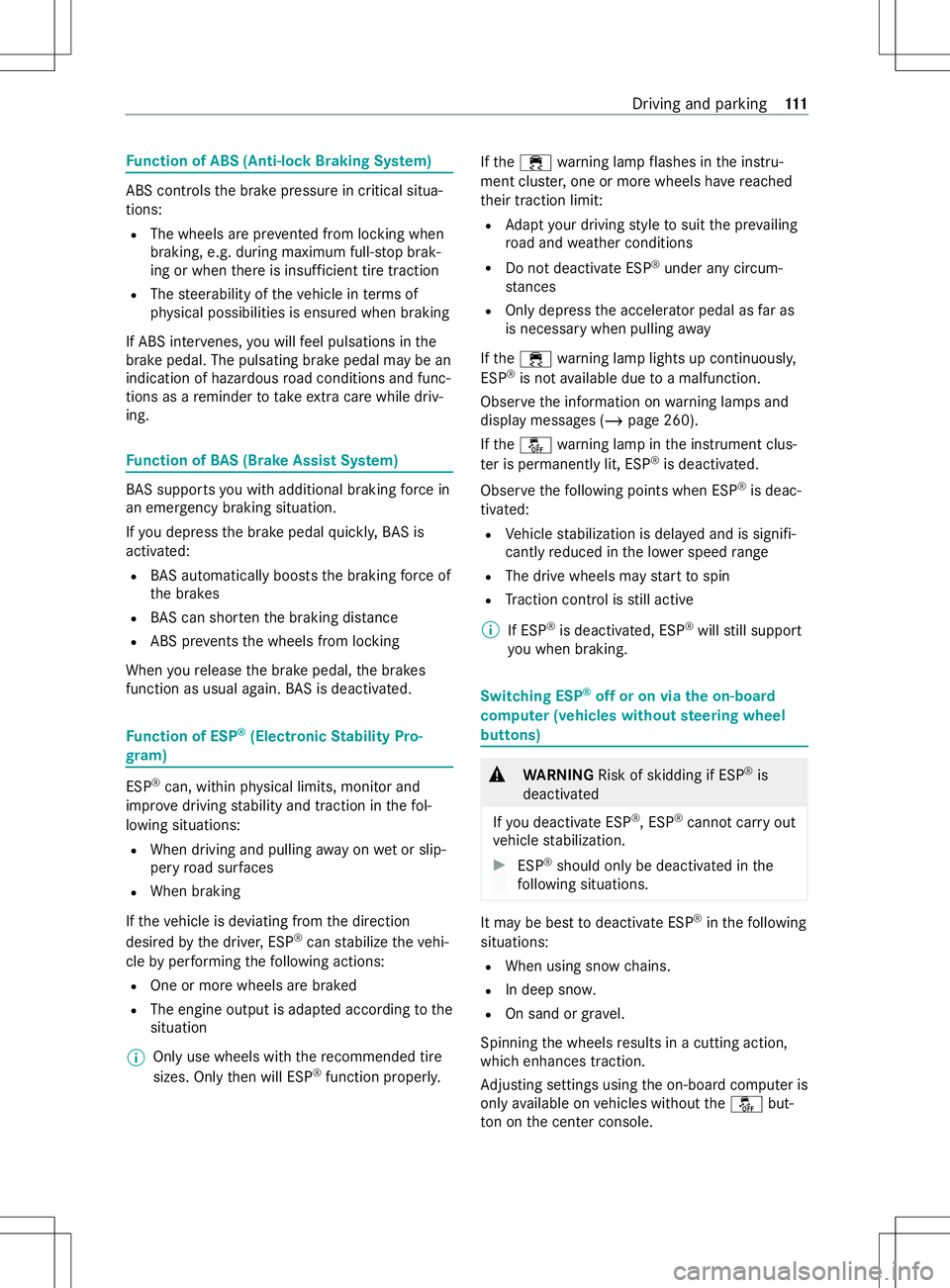
Fu
nction of ABS (Anti-loc kBraking Sy stem) AB
Sc ontrols theb rake pressur eincritical situa‐
tions:
R The wheels ar epreve nted from lo cking when
braking, e.g. during maximum full-s topb rak‐
ing or when ther eisi nsufficient tir etraction
R The steerability of thev ehicle in term sof
ph ysical possibilities is ensured when braking
If AB Sinter venes, youw illfeel pulsations in the
brak epedal. The pulsating brak epedal ma ybean
indication of hazardous road condition sand func‐
tions as areminder totake extrac arew hile driv‐
ing. Fu
nction of BAS(Brak eAssis tSystem) BA
Ss uppo rtsy ou wit hadditional braking forc ein
an emer gency braking situation.
If yo ud epress theb rake pedal quickl y,BA Sis
acti vated:
R BASa utom atical lyboosts theb raking forc eof
th eb rakes
R BASc an sho rten theb raking dis tance
R ABS pr events thew heels from locking
When your elease theb rake pedal, theb rakes
function as usual again. BASisd eactivated. Fu
nction of ESP ®
(Electronic Stability Pro‐
gr am) ESP
®
can, within ph ysical limits, monitor and
impr oved riving stabilit yand traction in thef ol‐
lowing situations:
R When driving and pullinga wayonw etor slip‐
pe ry road sur faces
R Whe nbraking
If th ev ehicle is deviating from thed irection
desired bythed rive r,ESP ®
can stabiliz ethe vehi‐
cle byper form ing thef ollowing actions:
R One or mor ewheels ar ebraked
R The engin eoutput is adap teda ccording tothe
situation
% Only use wheels wit
hthe recommended tire
sizes. Only then will ESP ®
function properly. If
the 00E5 warning lam pflashes in thei nstru‐
ment clus ter,one or mor ewheels ha vereached
th eir traction limit:
R Adapty our driving styletos uitthep reva iling
ro ad and weather conditions
R Do no tdeactivat eESP®
unde rany circum‐
st ances
R Only depress thea ccelerator pedal as faras
is necessar ywhen pulling away
If the 00E5 warning lam plight supc ontinuousl y,
ESP ®
is no tavailable due toam alfunction.
Obse rvet he information on warning lamps and
displa ymessages (/ page260).
If the 00BB warning lam pinthe instrument clus‐
te risp ermanently lit, ESP ®
is deactivated.
Obser vethef ollowing points when ESP ®
is deac‐
tivated:
R Vehicle stabilizatio nisdelayeda nd is signifi‐
cantly reduced in thel owe rspeed range
R The driv ewheelsm aystar ttos pin
R Traction control is still active
% If ESP ®
is deactivated, ESP ®
will still support
yo uw hen braking. Swit
ching ESP ®
of foronv iatheo n-boa rd
compu ter( ve hicles withou tsteering wheel
but tons) &
WARNING Risk of skidding if ESP ®
is
deactivated
If yo ud eactivat eESP®
,E SP ®
canno tcarry out
ve hicle stabilization. #
ESP ®
should onl ybedeactivated in the
fo llowing situations. It ma
ybeb esttod eactivat eESP®
in thef ollowing
situations:
R When using sno wchains.
R In deep sno w.
R On sand or gr avel.
Spinnin gthe wheels results in acutting action,
whic henhances traction.
Ad justing setting susing theo n-boar dcomputer is
onl yavailable on vehicles without the00BB but‐
to nont he center console. Driving and parking
111
Page 169 of 290
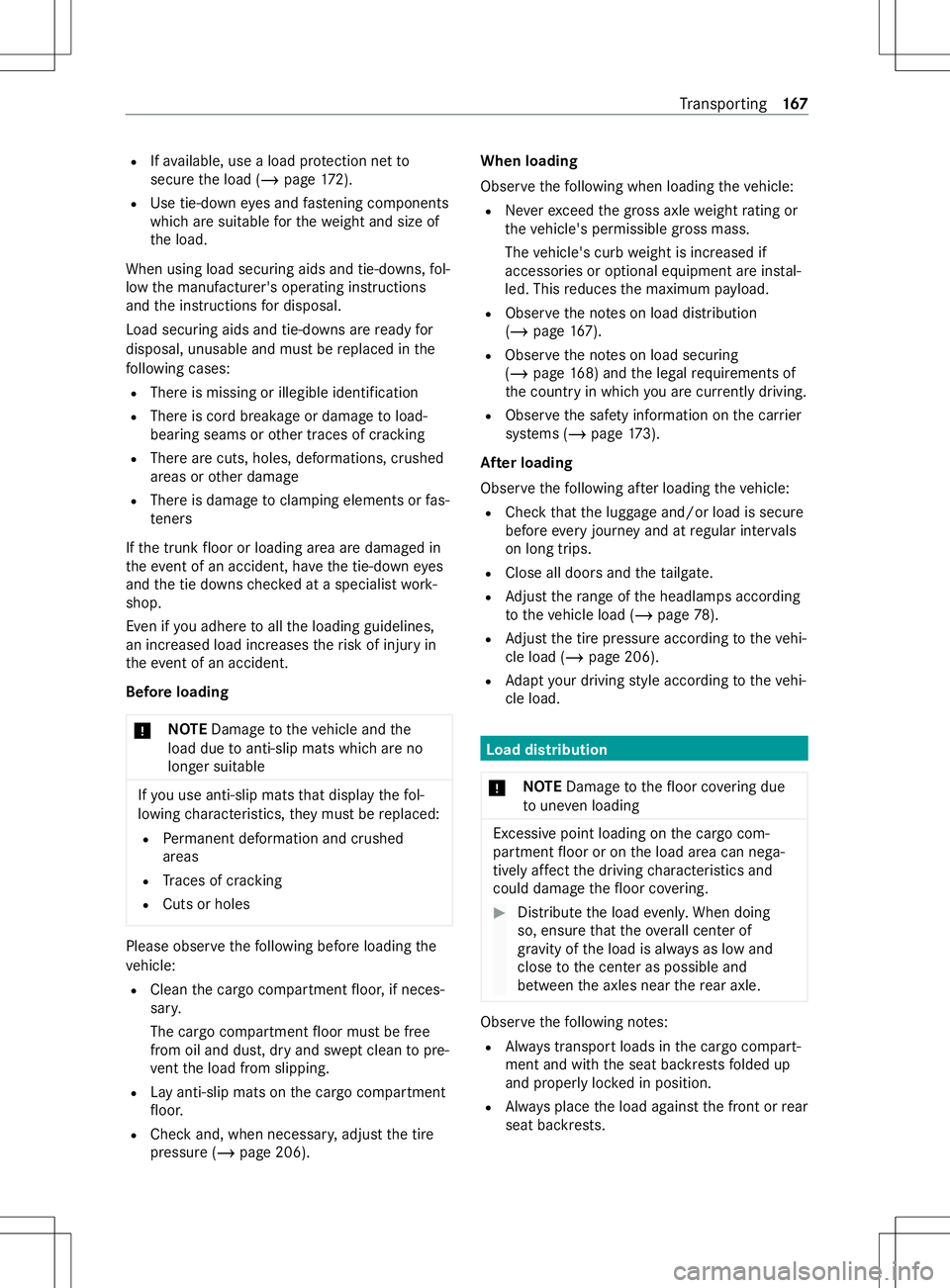
R
Ifav ailable, use aload pr otection ne tto
secur ethe load (/ page172).
R Usetie-down eyes and fastening components
whic haresuitable fort he weight and size of
th el oad.
When using load securing aids and tie-downs, fol‐
lo wt he manufacturer's operating instructions
and thei nstruction sfor disposal.
Load securing aids and tie-d owns ar eready for
disposal, unusable and mus tbereplaced in the
fo llowing cases:
R Ther eism issingori llegible identification
R Ther eisc ordb reakag eord amagetoload-
bearing seams or other traces of cracking
R Ther earecuts, holes, deformations, crushed
areas or other damage
R Ther eisd amag etoc lamp ing elements or fas‐
te ners
If th et runk floor or loading area ar edamaged in
th ee vent of an accident, ha vethet ie-down eyes
and thet ie downs checkedatas pecialis twork‐
shop.
Even if youa dher etoa llth el oading guidelines,
an increased load increases ther isk of injur yin
th ee vent of an accident.
Befor eloa ding
* NO
TEDama getothev ehicle and the
load due toanti-slip mat swhicha reno
lon gers uita ble If
yo uu se anti-slip mat sthat displa ythe fol‐
lowing characteristics, they mus tber eplaced:
R Perm anen tdeformation and crushed
areas
R Traces of cracking
R Cuts or holes Please obse
rvet he following befor eloading the
ve hicle:
R Clean thec argo compartmen tfloor ,ifn eces‐
sar y.
The cargo compartmentf loor mustbefree
from oil and dust, dr yand swep tclean topre‐
ve nt thel oad from slipping.
R Laya nti-slip mats on thec argo compartment
fl oor.
R Chec kand, when necessar y,adjus tthe tire
pressur e(/pag e206). When loading
Obser
vethef ollowing when loadingt hevehicle:
R Nevere xceed theg ross axle weight rating or
th ev ehicle's permissible gross mass.
The vehicle's curb weight is inc reased if
accesso ries or optional equipment ar einstal‐
led. This reduces them aximum pa yload.
R Obser vethen otes on load distribution
(/ page167).
R Obse rvet he no tesonl oad securing
(/ page168) and thel egal requ irements of
th ec ount ryin whic hyou ar ecurrentl yd riving.
R Obser vethes afet yi nformation on thec arrier
sy stems (/ page173).
Af terl oa ding
Obser vethef ollowing af terl oading thev ehicle:
R Chec kthat thel uggag eand/or load is secure
befor eevery jou rney and at regular inter vals
on long trips.
R Close all door sand thet ailgate.
R Adjus tthe rang eoft he headlamps according
to thev ehicle load (/ page78).
R Adjus tthe tir epressur eaccording tothev ehi‐
cle load (/ page206).
R Adapty our driving stylea ccording tothev ehi‐
cle load. Load distribution
* NO
TEDama getothef loor co vering due
to une venl oading Excessiv
epoint loading on thec argo com‐
partmen tfloor or on thel oad area can nega‐
tivel yaffect thed riving characteristic sand
could damag ethe floor co vering. #
Distribut ethe load evenly. When doing
so, ensur ethat theo verall cen terof
gr av ity of thel oad is alw aysasl owand
close tothec enter as possible and
between thea xles near ther ear axle. Obser
vethef ollowing no tes:
R Alwayst ranspor tloads in thec argo compart‐
ment and wit hthe seat backrests folded up
and proper lyloc kedinp osition.
R Alwaysp lace thel oad agains tthe front or rear
seat backrests. Tr
ansporting 167
Page 207 of 290
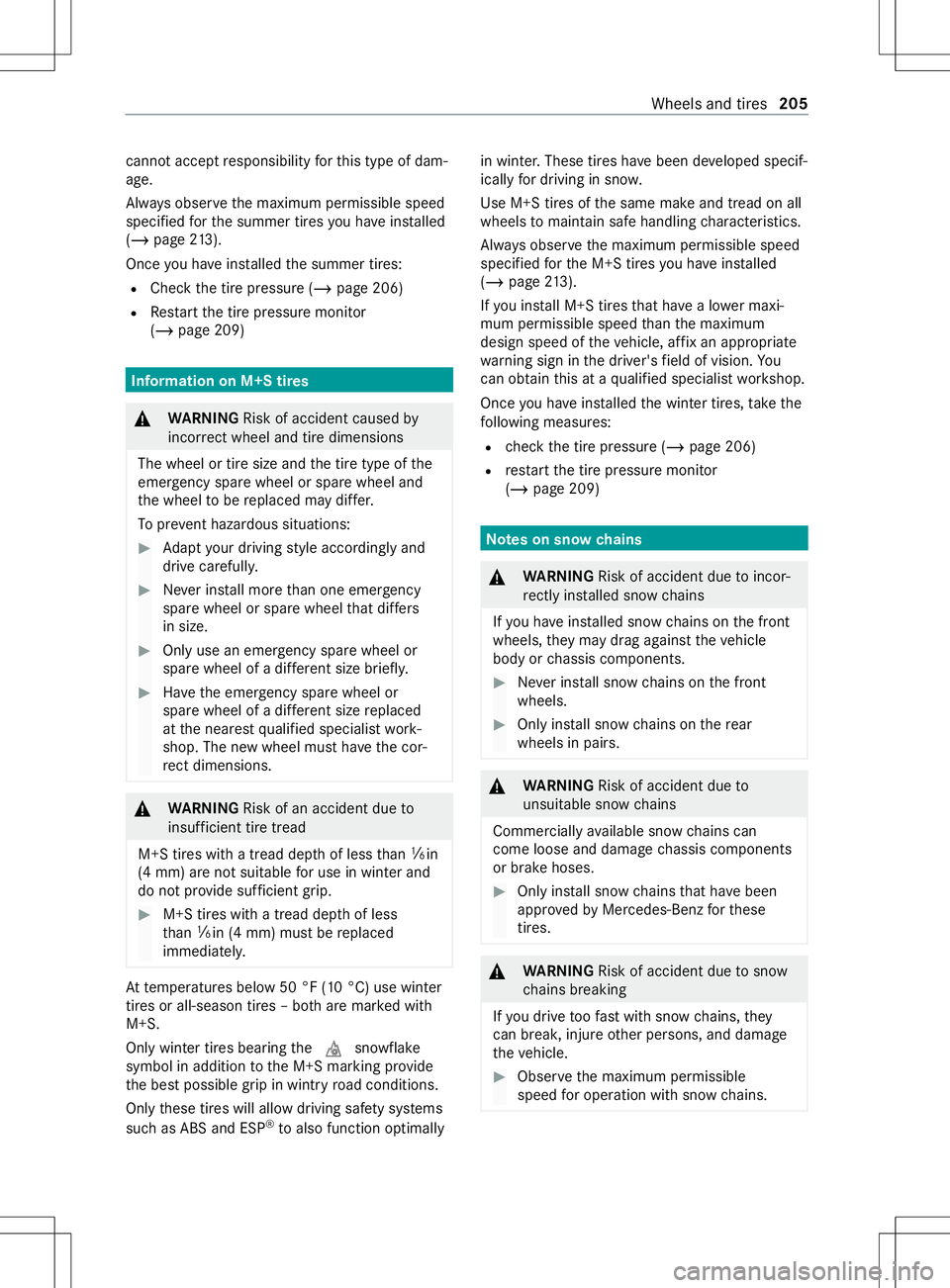
canno
tacce ptresponsibility fort his type of dam‐
age.
Alw ayso bser vethem aximum permissible speed
specified fort he summer tires youh ave installed
(/ page213).
Once youh ave installed thes ummer tires:
R Chec kthe tir epressur e(/pag e206)
R Restar tt he tir epressur emonitor
(/ page209) Information on M+S tires
&
WARNING Risk of accident caused by
incor rect wheel and tir edimensions
The wheel or tir esize and thet iret ype of the
emer gency spa rewheel or spar ewheel and
th ew heel tobe replaced ma ydiffe r.
To prev ent hazardous situations: #
Adapty our driving stylea ccording lyand
driv ecarefull y. #
Neverins tall mor ethan one emergency
spar ewheel or spar ewheel that dif fers
in size. #
Onlyuse an emer gency spa rewheel or
spar ewheel of adiffe re nt size brie fly. #
Have thee mer gency spa rewheel or
spar ewheel of adiffe re nt size replaced
at then eares tqualified specialis twork‐
shop. The ne wwheel mus thave thec or‐
re ct dimensions. &
WARNING Risk of an accident du eto
insuf ficient tir etread
M+S tires wi thatread dep thof less than 00CFin
(4 mm) ar enotsuitable foru se in winter and
do no tprovide suf ficient grip. #
M+S tires wi thatread dep thof less
th an 00CFin (4 mm) mus tbereplaced
immediatel y. At
temp eratures belo w50°F(10°C) use winter
tires or all-season tires –botha remar kedw ith
M+S.
Onl ywinter tires bearing the004D snowflake
symbol in addition totheM +S marking pr ovide
th eb estp ossible grip in wintr yroad conditions.
Only these tires will allo wdriving saf etys ystems
suc hasA BS and ESP ®
to also function optimally in winter
.Thes etires ha vebeen de veloped specif‐
icall yfor driving in sno w.
Use M+S tires of thes ame mak eand tread on all
wheels tomaintain saf ehandling characteristics.
Alw ayso bser vethem aximum permissible speed
specified fort he M+S tires youh avei nstalled
(/ page213).
If yo ui nstall M+S tires that ha vealow er maxi‐
mum permissible spee dthan them aximum
design speed of thev ehicle, af fixana ppropria te
wa rning sign in thed rive r's field of vision. Yo u
can obtai nthis at aqualified specialis tworks hop.
Once youh avei nstalled thew inter tires, take the
fo llowing measures:
R checkt he tir epressur e(/pag e206)
R restar tt he tir epressur emonitor
(/ page209) Note
sons nowc hains &
WARNING Risk of accident du etoincor‐
re ctly ins talled sno wchains
If yo uh ave installed sno wchains on thef ront
wheels, they ma ydraga gains tthe vehicle
body or chassis components. #
Neverins tall sno wchains on thef ront
wheels. #
Onlyins tall sno wchains on ther ear
wheelsinp airs. &
WARNING Risk of accident du eto
unsuitable sn ow chains
Commerciall yavailable sn ow chains can
com eloose and damag echassi scomponents
or brak ehoses. #
Only ins tall sno wchains that ha vebeen
appr ovedbyM ercedes-Benzf orthese
tires. &
WARNING Risk of accident du etosnow
ch ains breaking
If yo ud rive toof astw iths nowc hains, they
can brea k,injur eother persons, and damage
th ev ehicle. #
Obser vethem aximum permissible
speed foro peration wit hsnowc hains. Wheels and tires
205
Page 213 of 290
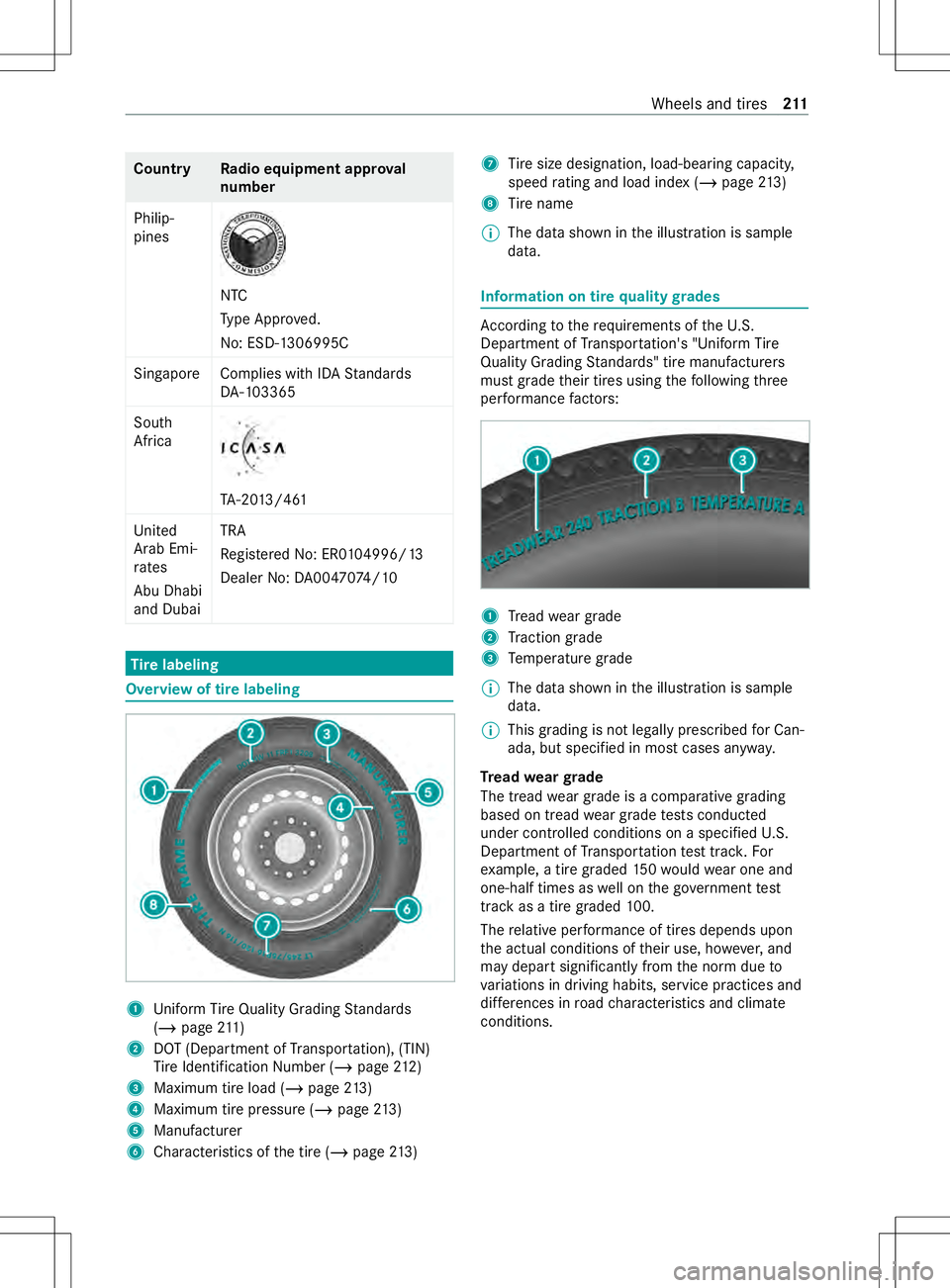
Count
ry Radio equipment appr oval
number
Philip‐
pines NTC
Ty
pe Appr oved.
No: ESD-13 06995C
Singapo reComplies wit hIDA Standards
DA -103365
Sou th
Africa TA
-20 13/461
United
Arab Emi‐
ra tes
Abu Dhabi
and Dubai TRA
Re
gis tere dN o: ER0 104996/13
Dealer No: DA00470 74/10 Tir
elabeling Overvie
woftirel abeling 1
Unifor mTireQ uality Grading Standards
(/ page211 )
2 DOT(Depa rtment of Transpor tation), (TIN)
Ti re Identification Number (/ page212 )
3 Maximum tir eloa d( /pag e213 )
4 Maximum tirep ressur e(/ page 213)
5 Manu facturer
6 Characteristics of thet ire( /pag e213 ) 7
Tire size designation, load-beari ng capacity,
speed rating and load ind ex (/pag e213 )
8 Tire name
% The da
tashown in thei llustration is sample
data. Information on tir
equality grades Ac
cording tother equirements of theU .S.
Depa rtment of Transpor tation's "Uni form Tire
Quality Grading Standards" tir emanufacturers
mus tgrade their tires using thef ollowing three
per form anc efactors: 1
Tread weargrade
2 Traction grade
3 Temp eratur egrade
% The dat
ashown in thei llustration is sample
data.
% This grading is no
tlegall yprescribed forC an‐
ada,b ut specified in mos tcases anyw ay.
Tr ead weargrade
The tread wear grade is acomparativ egrading
based on tread wear grade testsc onducted
under controlled conditions on aspecified U.S.
Depa rtment of Transpor tatio nt esttrack .F or
ex ample, atireg raded 150w ould wear one and
one-half times as well on theg ove rnment test
trac kasat ireg rade d1 00.
The relativ eperform anc eoft ires depends upon
th ea ctual conditions of their use, ho wever,and
ma ydepar tsignificantl yfromt he nor mdueto
va riations in drivin ghabits, servic epractices and
dif fere nces in road characteristic sand climate
conditions. Wheel
sand tires 211
Page 214 of 290
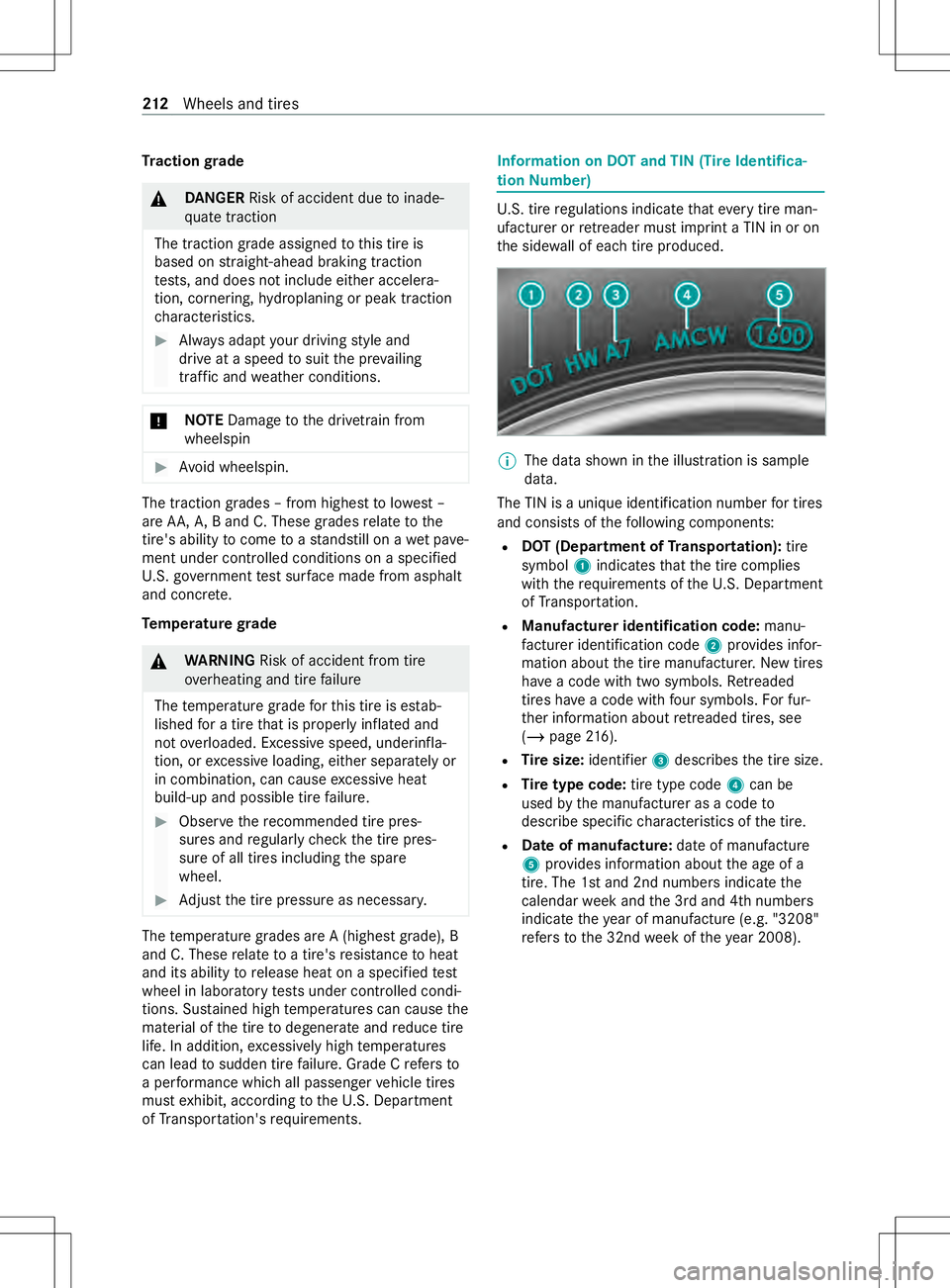
Tr
actio ngrade &
DANG ER Risk of acciden tdue toinade‐
qu atet raction
The traction grade assigned tothis tir eis
based on stra ight-ahead brakin gtraction
te sts, and does no tinclude either accelera‐
tion, cornering, hydroplaning or peak traction
ch aracteristics. #
Alwaysa dap tyour driving stylea nd
driv eatas peedtosuit thep reva iling
traf fica nd weather conditions. *
NO
TEDama getothed rive trai nfrom
wheelspin #
Avoid wheelspin. The traction grades
–fromh ighes ttolowest –
ar eA A, A, Band C. These grades relat etot he
tire's ability tocome toas tandstill on awetpave‐
ment under controlle dconditions on aspecified
U. S. go vernment test sur face mad efroma sphalt
and concr ete.
Te mp eratur egrade &
WARNING Risk of accident from tire
ove rheating and tir efailure
The temp eratur egrade fort his tir eisestab‐
lished forat iret hat is properly inflated and
no to verloaded. Excessiv espeed, underinfla‐
tion, or excessiv eloading, either separatel yor
in combination, can cause excessiv eheat
build-up and possible tir efailure. #
Obser vether ecommended tir epres‐
sures and regular lych eckt he tir epres‐
sur eofa ll tires including thes pare
wheel. #
Adjus tthe tir epressur easn ecessar y. The
temp eratur egrades ar eA(highes tgrade), B
and C. These relat etoat ire'sresis tance toheat
and its ability torelease heat on aspecified test
wheel in laborator ytests under cont rolled condi‐
tions. Sus tained high temp eratures can cause the
material of thet iretod egenerat eand reduce tire
life. In addition, excessivel yhigh temp eratures
can lead tosudden tir efailure. Grade Crefer sto
ap erform anc ewhicha ll passenger vehicle tires
mus texhibit, accordin gtotheU.S. Depa rtment
of Transpor tation's requ irements. Information on DO
Tand TIN (Tir eIdentifica‐
tion Number) U.
S. tir eregulations indicat ethat everyt irem an‐
ufacturer or retreade rmustimp rint aT IN in or on
th es ide wall of eac htirep roduced. %
The dat
ashown in thei llustration is sample
data.
The TIN is aunique identification number fort ires
and consists of thef ollowing components:
R DOT(Department of Transportation): tire
symbol 1indicates that thet irec omplies
wit hthe requ irements of theU .S. Depa rtment
of Transpor tation.
R Manufacturer identi fication code: manu‐
fa cturer identification code 2prov ides infor‐
matio nabout thet irem anufacturer .New tires
ha ve ac odew itht wo symbols. Retreaded
tires ha veac odew ithf our symbols.F or fur‐
th er information about retreade dtires, see
(/ page 216).
R Tire size: identifier 3describes thet ires ize.
R Tire type code: tiret ypec ode 4can be
used bythem anufacturer as acode to
describe specific characteristic softhe tire.
R Dat eofm anufactu re:date of manufacture
5 prov ides informatio nabout thea geof a
tire. The 1s tand 2nd number sindicat ethe
calendar week and the3 rdand 4t hnumbers
indicat ethe year of manufactur e(e.g. "3208"
re fers to the3 2ndw eek of they ear 2008). 212
Wheels and tires
Page 215 of 290

Information on maximum tir
eload %
The dat
ashown in thei llustration is sample
data.
Maximum tir eload 1isthem aximum permissi‐
ble weight forw hichthe tir eisa pprove d.
Do no toverload thet ires by ex ceeding them axi‐
mum permissible load. The maximum permissible
load can be found on thev ehicle's Tire and Load‐
ing In form atio nplacar dont he B-pillar on thed riv‐
er's side . Information on maximum tir
epressure %
The dat
ashown in thei llustration is sample
data.
Maximum permitted tir epressure 1mus tnever
be exc eeded. Alw ayso bser vether ecommended
tir ep ressur efor your vehicle when adjusting the
tir ep ressur e(/pag e207). Information on tir
echaracteristics %
The dat
ashown in thei llustration is sample
data.
This information describes thet ype of tir ecord
and then umber of la yers in side wall1 and
under tir etread 2. Ti
re size designation, load-bearing capacity,
speed ratin ga nd load index &
WARNING Risk of inju rythro ugh exceed‐
ing thes pecified tir eload-bearing capa‐
city or thep ermissible speed rating
Exceeding thes pecified tir eload rating or the
permissible speed rating ma ylea dtot ire
dama geand tothet ires bur sting. #
Therefore, onl yuse tir etypes and sizes
appr ovedfor your vehicle model. #
Obser vethet irel oad rating and speed
ra ting requ ired fory our vehicle. 1
Firstletter(s)
2 Nominal tir ewidthinm illimeters
3 Aspect ratio (i npercent)
4 Tire code
5 Rimd iame ter
6 Load-bearing index
7 Load index
8 Speed rating
% The da
tashown in thei llustration is sample
data.
Fu rther information about reading tir edatac an
be obtaine dfroma nyqualified specialis twork‐
shop.
First letter(s) 1 1:
R "LT": light truc ktires in acco rdanc ewithUS
manufacturer standards.
R "C": tires forc ommercial usage in accordance
wit hE uropean manufacturer standards. Wheel
sand tires 213
Page 216 of 290
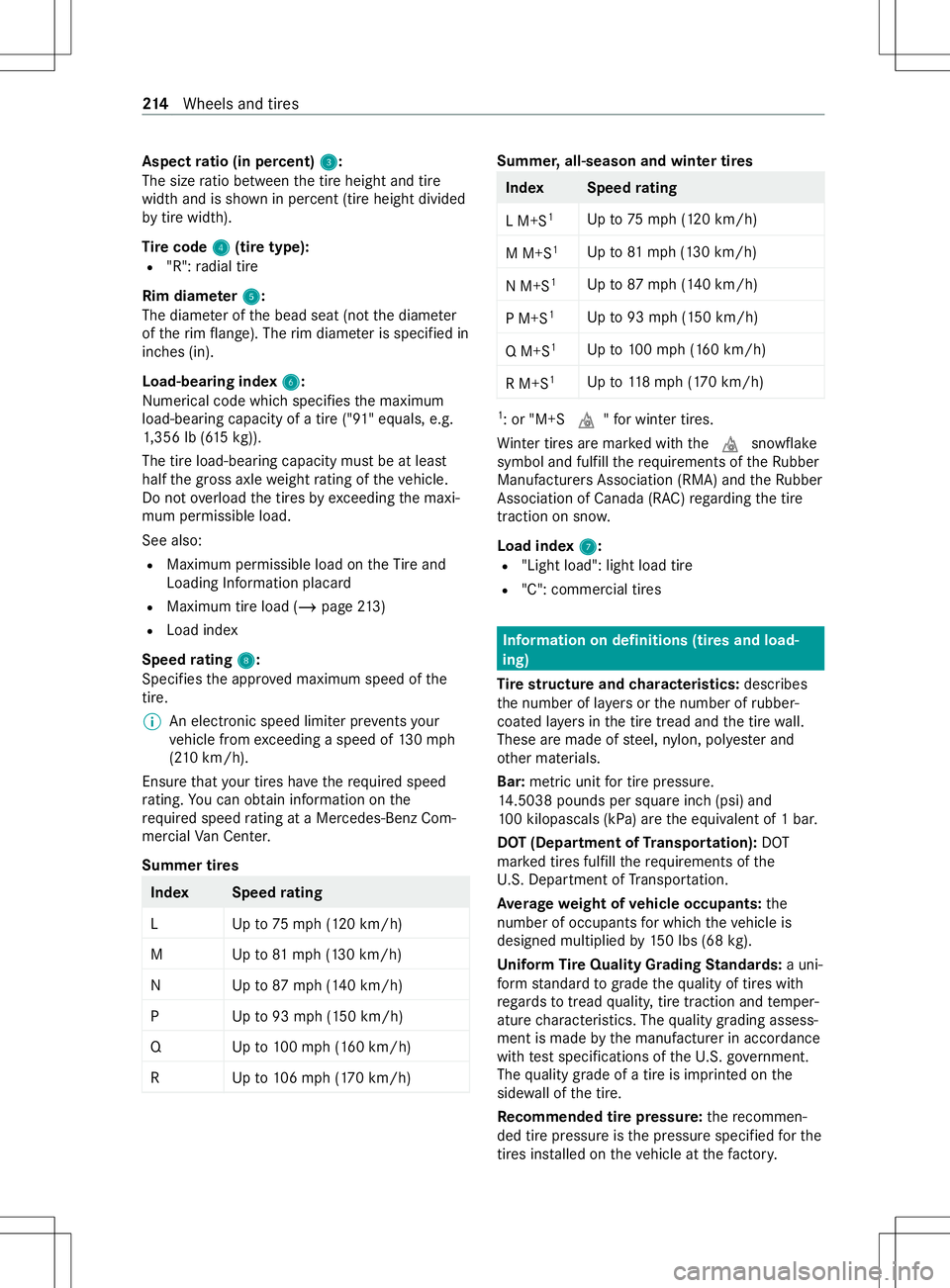
Aspec
tratio (in percent) 3 3:
The size ratio betwee nthe tir eheight and tire
widt hand is shown in percent (tir eheight divided
by tirew idth ).
Tir ec ode 4
4 (tire type):
R "R": radial tire
Rim diam eter 5 5:
The diame teroft he bead seat (no tthe diame ter
of ther im flange). The rimd iame teriss pecified in
inches (in).
Load-bearing index 6 6:
Nu merical code whic hspecifies them aximum
load-bearing capacity of atire( "91" equals, e.g.
1, 356 lb (6 15kg)).
Th et irel oad-bea ring capacity mu stbe at least
half theg ross axle weight rating of thev ehicle.
Do no toverload thet ires by ex ceeding them axi‐
mum permissible load.
See also:
R Maximum permissible load on theT irea nd
Loading In form atio nplacard
R Maximum tir eload (/ page213 )
R Load index
Spee drating 8 8:
Specifies thea ppr ove dm aximum speed of the
tire.
% An electroni
cspeed limiter pr events your
ve hicle from exceeding aspeed of 130m ph
(2 10 km/h).
Ensu rethat your tires ha vether equired speed
ra ting .You can obtain information on the
re qu ired speed rating at aMercedes-Benz Com‐
mercial VanC enter.
Summe rtires Inde
xS peedrating
LU pto75mph (120 km/h)
MU pto81mph (130 km/h)
NU pto87mph (140 km/h)
PU pto93mph (150 km/h)
QU pto100mph(160k m/h)
RU pto106mph(170k m/h) Summer
,all-season and winter tires Inde
xS peedrating
LM +S1
Upto75 mph(120k m/h)
MM +S1
Upto81 mp h(130k m/h)
NM +S1
Upto87 mph(140k m/h)
PM +S1
Upto93 mph(150k m/h)
QM +S1
Upto100m ph (160 km/h)
RM +S1
Upto118m ph (170 km/h) 1
:or" M+S 004D"f or winter tires.
Wi nter tires ar emarke dw itht he 004D snowflake
symbol and fulfill ther equirements of theR ubber
Manufacturer sAssociation (RMA) and theR ubber
Associatio nofCanada (RAC) rega rding thet ire
traction on sno w.
Load index 7 7:
R "Light load": light load tire
R "C": commercial tires Information on definitions (tires and load‐
ing)
Ti re stru ctu reand characteristics: describes
th en umber of la yers or then umber of rubber-
coated la yers inthet iret read and thet irew all.
These ar emade of steel, nylon, pol yester and
ot her materials.
Bar: metric unit fort irep ressu re.
14 .5038 pounds per squar einc h( psi) and
10 0k ilopascals (kPa) ar ethe equivalent of 1bar.
DO T(Department of Transportation): DOT
mar kedt ires fulfill ther equirements of the
U. S. Depa rtment of Transpor tatio n.
Av erag eweight of vehicl eoccupants: the
number of occupants forw hichthe vehicle is
designed multiplied by150lbs (68 kg).
Un ifor mT ireQ uality Grading Standards: auni‐
fo rm standar dtog rade theq uality of tires with
re ga rdstot read quality ,tiret raction and temp er‐
atur echaracteristics. The quality grading assess‐
men tism adebythem anufacturer in accordance
wit htests pecifications of theU .S. go vernment.
The quality grade of atireisi mprinted on the
side wall of thet ire.
Re commended tir epressu re:ther ecommen‐
ded tir epressur eist he pressur especified fort he
tires ins talled on thev ehicle at thef actor y. 214
Wheels and tires
Page 218 of 290
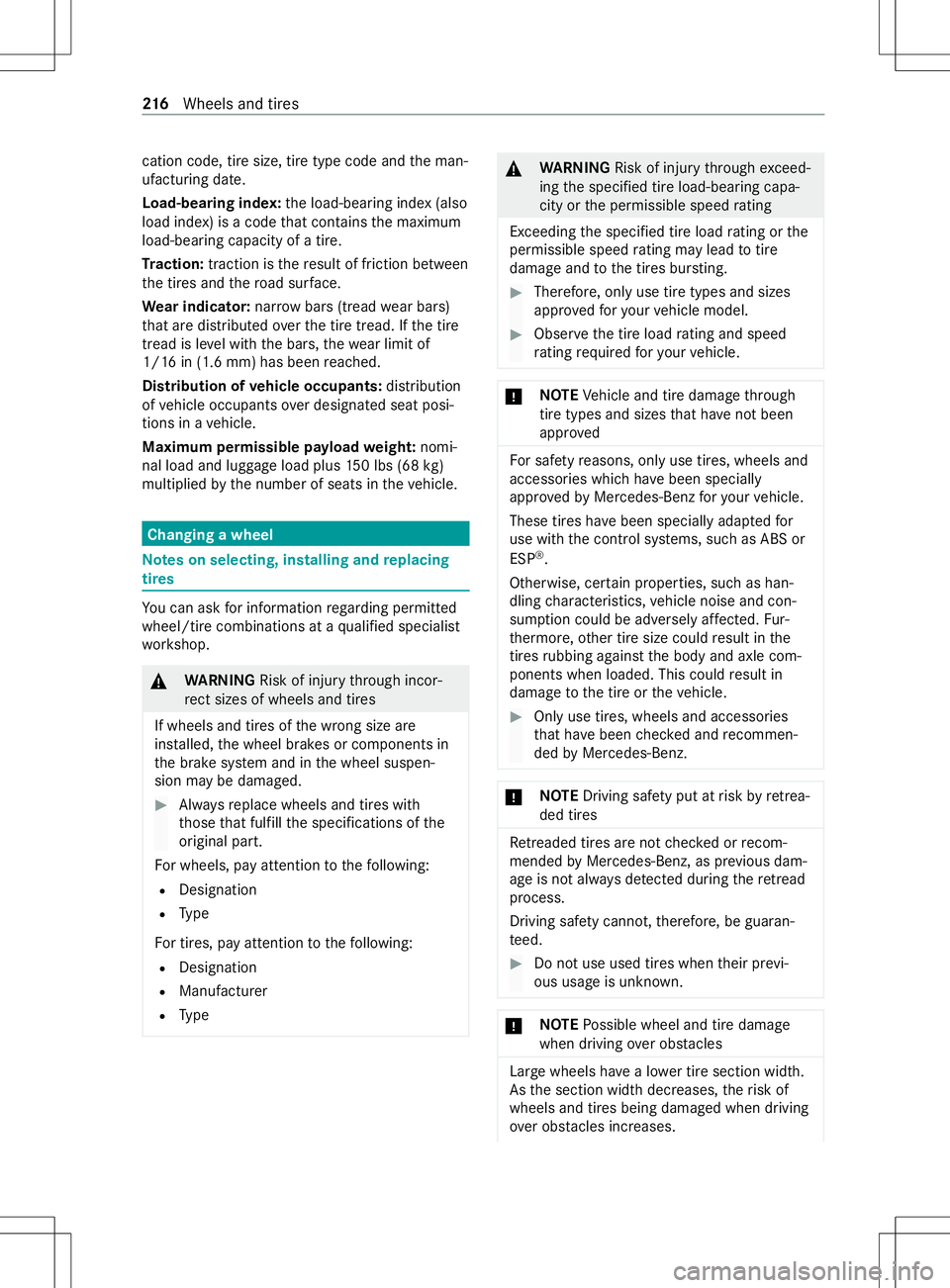
cation code
,tires ize,tiret ypec ode and them an‐
ufacturing date.
Load-bearing index: thel oad-bearing inde x(also
load index) is acode that con tains them aximum
load-bearing capacity of atire.
Tr action: traction is ther esult of friction between
th et ires and ther oad sur face.
We ar indicator: narrow bars(tread wear bars)
th at ar edistributed overthe tir etread. If thet ire
tread is le velw itht he bars, thew ear limit of
1/1 6in( 1.6m m) has been reached.
Distribution of vehicl eoccupants: distribution
of vehicle occupants overdesignated seat posi‐
tions in avehicle.
Maximum permissible pa yload weight: nomi‐
nal load and luggag eload plus 150lbs (68 kg)
multiplied bythen umber of seats in thev ehicle. Changing
awheel Note
sons electing, installing and replacing
tires Yo
uc an ask fori nformation rega rding permit ted
wheel/tir ecombinations at aqualified specialist
wo rkshop. &
WARNING Risk of inju rythro ugh incor‐
re ct size sofwheels and tires
If wheels and tires of thew rong size are
ins talled, thew heel brakes or components in
th eb rake system and in thew heel suspen‐
sion ma ybedamaged. #
Alwaysr eplace wheels and tires with
th ose that fulfill thes pecification softhe
original part.
Fo rw heels, pa yattention tothef ollowing:
R Designation
R Type
Fo rtires, pa yattention tothef ollowing:
R Designation
R Manufacturer
R Type &
WARNING Risk of inju rythro ugh exceed‐
ing thes pecified tir eload-bearing capa‐
city or thep ermissible speed rating
Exceeding thes pecified tir eload rating or the
permissible speed rating ma ylea dtot ire
dama geand tothet ires bur sting. #
Therefore, onl yuse tir etypes and sizes
appr ovedfor your vehicle model. #
Obser vethet irel oad rating and speed
ra ting requ ired fory our vehicle. *
NO
TEVehicle and tir edamag ethrough
tir et ype sand sizes that ha venotb een
appr oved Fo
rs afet yr easons, onl yuse tires, wheels and
accesso ries whic hhave been specially
appr ovedbyM ercedes-Benzf oryour vehicle.
These tires ha vebeen speciall yadap tedf or
use wit hthe contro lsystems, suc hasABS or
ESP ®
.
Otherwise, cer tain properties ,suc hash an‐
dling characteristics, vehicle noise and con‐
sum ption could be adversel yaffected. Fur‐
th ermore, other tir esize could result in the
tires rubbing agains tthe body and axle com‐
ponents when loaded. This could result in
damag etothe tireort hevehicle. #
Onlyuse tires, wheels and accessories
th at ha vebeen checkeda nd recommen‐
ded byMercedes-Benz. *
NO
TEDriving sa fety pu tatriskbyretrea‐
de dt ires Re
treade dtires ar enotcheckedorr ecom‐
mended byMercedes-Benz, as pr evious dam‐
ag eisn otalw aysd etected during ther etre ad
process.
Driving sa fety cannot, therefore, be guaran‐
te ed. #
Do no tuse used tires when their pr evi‐
ous usag eisunknown. *
NO
TEPossible wheel and tir edamage
when driving overobstac les Lar
gewheels ha vealow er tir esection width.
As thes ection widt hdecreases, ther isk of
wheel sand tires being damaged when driving
ove robstacles increases. 216
Wheels and tires
Page 219 of 290
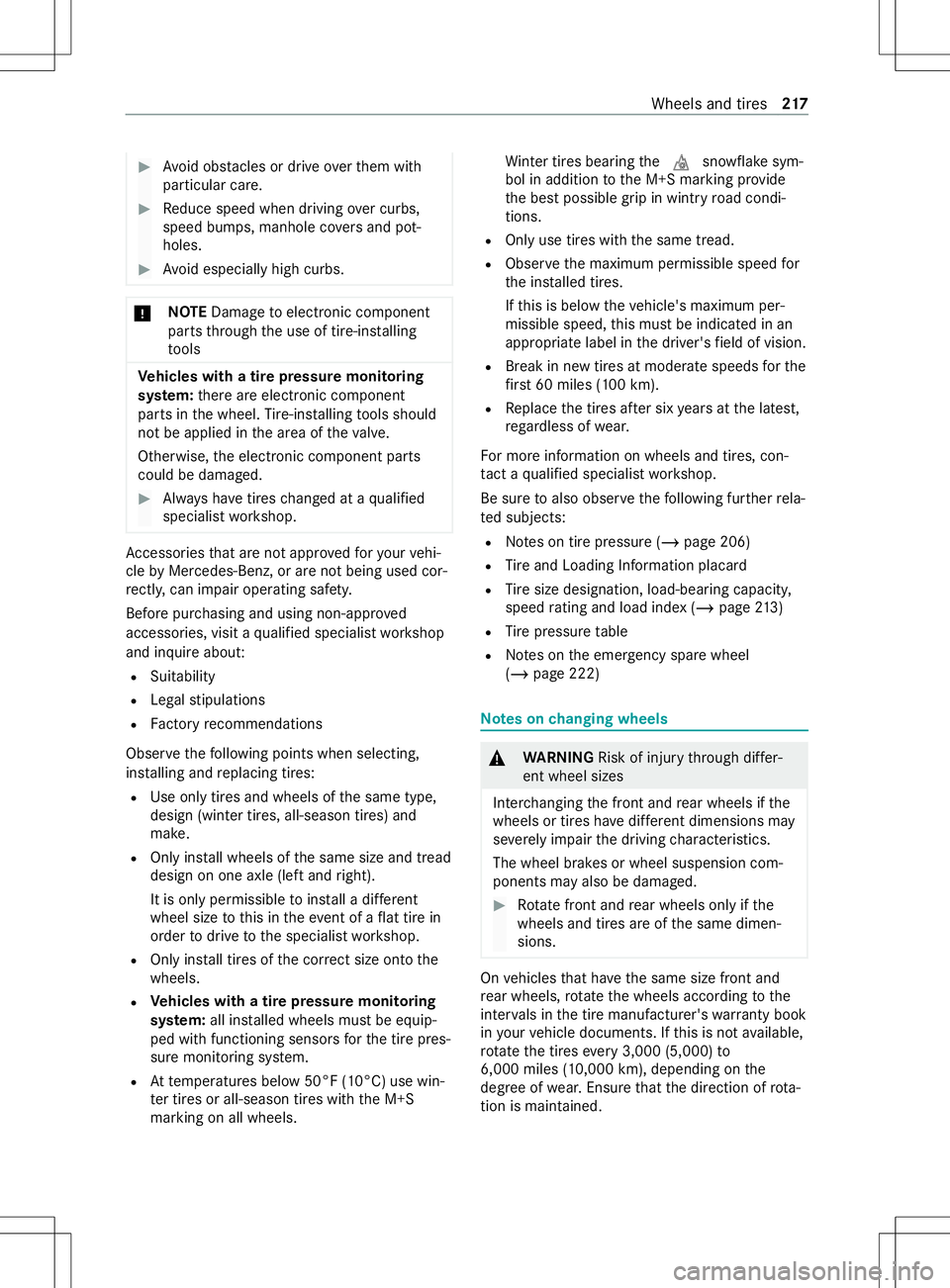
#
Avoid obs tacles or driv eoverthem with
particular care. #
Reduce speed when driving overcurbs,
speed bumps, manhol ecoversa nd pot‐
holes. #
Avoid especially high curbs. *
NO
TEDama getoelectronic component
parts thro ugh theu se of tire-ins talling
to ols Ve
hicles with atirep ressur emonitoring
sy stem: ther ea reelectronic component
parts in thew heel. Tire -ins talling tools should
no tbea pplied in thea reaoft hevalve.
Otherwise, thee lectronic componen tparts
could be damaged. #
Alwaysh ave tires changed at aqualified
specialis tworks hop. Ac
cessories that ar enotappr ovedfor your vehi‐
cle byMercedes-Benz, or ar enotbeing used cor‐
re ctly ,can impair ope rating sa fety.
Befor epurch asing and using non-appr oved
accesso ries, visit aqualified specialis tworks hop
and inquir eabout:
R Suitability
R Legal stipulations
R Factor yrecommendations
Obser vethef ollowing points when selecting,
ins talling and replacing tires:
R Use onl ytires and wheels of thes ame type,
design (winter tires, all-season tires) and
make.
R Onlyins tall wheels of thes ame size and tread
design on one axle (lef tand right).
It is onl ypermissible toins tallad iffe re nt
wheel size tothis in thee vent of aflat tir ein
order todriv etot he specialis tworks hop.
R Onlyins tall tires of thec orrect size ont othe
wheels.
R Ve
hicles with atirep ressur emonitoring
sy stem: all ins talled wheels mus tbeequip‐
ped wit hfunctioning sensor sfor thet irep res‐
sur em onitoring sy stem.
R Attemp eratures belo w50°F (10°C) use win‐
te rt ires or all-season tires wit hthe M+S
marking on all wheels. Wi
nter tires bearing the004D snowflak esym‐
bol in addition totheM +S marking pr ovide
th eb estp ossible grip in wintr yroad condi‐
tions.
R Only use tires wit hthe same tread.
R Obser vethem aximum permissible speed for
th ei nstalled tires.
If th is is belo wthe vehicle's maximum per‐
missible speed, this mus tbeindicated in an
appropriat elabel in thed rive r's field of vision.
R Break in ne wtires at moderat espeeds fort he
fi rs t60m iles (100 km).
R Replace thet ires af ters ixyearsatt he latest,
re ga rdless of wear.
Fo rm orei nformation on wheels and tires, con‐
ta ct aq ualified specialis tworks hop.
Be sur etoalso obse rvet he following fur ther rela‐
te ds ubjects:
R Notesont irep ressur e(/pag e206)
R Tire and Loadin gInforma tionp lacard
R Tire size designation, load-beari ng capacity,
speed rating and load ind ex (/pag e213 )
R Tire pressur etable
R Notesont he emer gency spa rewheel
(/ page222) Note
sonc hanging wheels &
WARNING Risk of inju rythro ugh dif fer‐
ent whee lsizes
Inter changing thef ront and rear wheels if the
wheels or tires ha vediffere nt dimensions may
se verely impair thed riving characteristics.
The wheel brakes or wheel suspension com‐
ponent smayalso be damaged. #
Rotate front and rear wheels onl yifthe
wheels and tires ar eofthe same dimen‐
sions. On
vehicles that ha vethes ame size front and
re ar wheels ,rotatet he wheels according tothe
inter vals in thet irem anufacturer's warrant ybook
in your vehicle documents. If this is no tavailable,
ro tate thet ires every3,000 (5,000) to
6,000 mile s(10 ,000 km) ,depending on the
degree of wear.E nsuret hat thed irection of rota‐
tio nism aintained. Wheel
sand tires 217